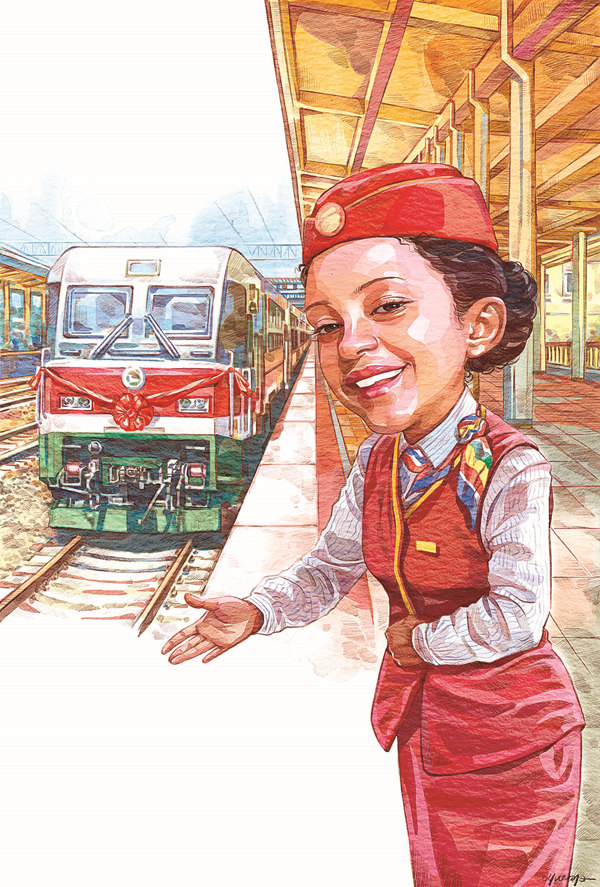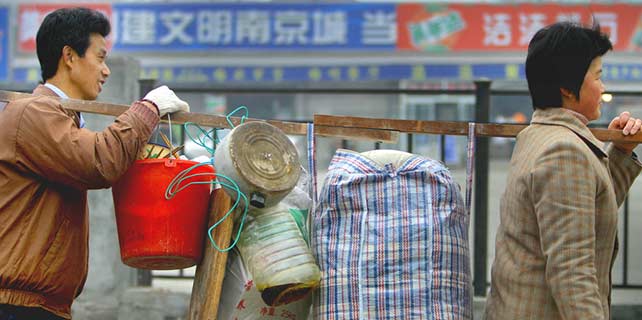Progress on track

As the electrified Ethiopia-Djibouti train pulls out of Furi-Lebu station in Addis Ababa, Omar Nour cannot contain his excitement.
“This is the Chinese way, fast and efficient,” he says of the 120 kilometer per hour train after its inauguration in early October.
“China’s impetus to modernize and improve our infrastructure has a direct impact on our standard of living. Djibouti will become the gateway of the region,” says the 60-year-old entrepreneur as he enjoys a ride on the $3.78 billion train during its official test run.
The 750 km track runs parallel to the now-abandoned meter-gauge line built by the French in 1910. Years of underinvestment have seen Ethiopia cut off from direct access to the port of Djibouti, where the landlocked country does around 70 percent of its trading. All freight is transported by road.
Convenience is what has Nour excited. As a meat exporter, prevailing circumstances have forced him to rely on road transport, which is risky, slow and most times affects the weight of his cows and goats. His abattoir is located in Ethiopia and his products take at least seven days to reach the port in Djibouti, a journey fraught with risks.
Construction of the modern track took just three years.
“I am happy that it is finally complete,” he says. “I will be able to manage my costs.”
He exports about 10 metric tons daily and predicts an upswing to a million tons over the next five years using trains with 3,000 tons gross capacity as he starts to trade with the Middle Eastern countries.
“China has pushed the bar higher,” he says.
According to African Development Bank Group, Africa’s prolonged underinvestment in transportation has resulted in dilapidated infrastructure. African countries on average invested 15 to 25 percent of GDP in transport infrastructure over the period 2005-12, while India and China invested about 32 and 42 percent respectively in the same period.
This underinvestment has resulted in Africa having considerably higher transport costs (as much as 100 percent) than other low-income developing countries.
The continent’s rail network represents just 5 percent of the 1 million km worldwide. As of 2015, China boasted 121,000 km of railways, the world’s second-longest network, including 19,000 km of high-speed rail, the longest such network in the world.
“Rail infrastructure in Africa is skimpy and currently not as well developed as the road network,” says Symerre Grey-Johnson, head of the regional integration and trade division at New Partnership for Africa’s Development, an economic development program of the African Union.
“Investment in this subsector was never prioritized but the need for transborder infrastructure, which is fast and low-cost, is certainly urgent at the moment. This will especially support mineral-rich landlocked countries.”
The colonial builders were not keen to promote intratrade, Grey-Johnson says.
He adds that Africa’s current campaign to industrialize makes rail infrastructure a necessity.
“This is the only way the continent is going to build and sustain desired economic growth.”
The Ethiopia-Djibouti railway traverses two countries, giving the former a faster route to the port. The standard gauge railway has been developed by China Railway Engineering Corp for the Ethiopian side, while China Civil Engineering Construction Corp completed the Djibouti side. China Export and Import Bank loaned 70 percent of the investment.
“The railway is the first standard gauge electrified railway constructed in Africa by Chinese enterprises,” says Li Changjin, chairman of the board of China Railway Group and China Railway Engineering Corp.
“The standard of China’s railway technology and equipment has reached first-class level,” he says.
The African rail industry is estimated to be a $508 billion market. This includes current and proposed investments.
Access to affordable capital, a large presence in Africa and strengthened bilateral relations have allowed Chinese firms to clinch lucrative contracts such as the Lagos-Calabar and Lagos-Kano route in Nigeria, the Mombasa-Nairobi railway in Kenya, Chad-Sudan railways and Khartoum-Port Sudan in Sudan and the Angola-Zambia-Congo project. Recently, CCECC signed a $2.26 billion deal to build a new railway linking two cities in eastern Zambia.
Chinese firms are also eyeing projects in Senegal, Uganda, Tanzania and Rwanda to add to the feat of building the famous Tanzania-Zambia railway.
“It is symbolic of ongoing relations between China and Africa,” says Deniz Kellecioglu, economic affairs officer at the Macroeconomic Policy Division of the United Nations Economic Commission of Africa. “Regional integration has been brought closer since this infrastructure, Ethiopia-Djibouti rail, will also interlink with the Kenyan SGR that connects South Sudan. It is a game-changer.”
He says long-term investment promises to trigger the sustained economic growth that has been absent.
“People will also start planning long-term and investing in sectors such as manufacturing. Thinking long-term is a global phenomenon, but the infrastructure deficit witnessed in Africa is proof that this has been lacking.”
The direct benefits to be seen are reduced transportation costs, increased industrialization prospects and the establishment of new industries to support the railway sector. This is in addition to job-creation and capacity-building which make a direct contribution to GDP.
“You only have to see the catalytic effect of what these projects do along the routes. Areas that previously had no access to water get boreholes. Locals become service providers for the projects, hence using more labor,” says the ECA economist. He especially cites the Ethiopia-Djibouti electrified railway, saying this has taken energy closer to the people, thus driving socio-economic activities in rural areas.
“Small and medium-sized entrepreneurs are the biggest beneficiaries of these projects.”
More interestingly, remote territories will be opened up.
“It will also cool neighborly tensions, since countries trading with each other tend to largely maintain peace,” says Kellecioglu.
Unexplored areas mean untapped economic potential in the agriculture and mining, sectors that require an efficient transportation network.
But issues such as the displacement of people, unemployment as the network becomes more efficient and the rise of competing political interests have threatened to derail projects.
In Kenya, the Mombasa-Nairobi SRG has been severely interrupted by community disagreements over land compensation, labor disputes and environmental activists opposed to it cutting across a national park.
However, such problems have not occurred in neighboring Ethiopia, where Abebe Bayu, a journalist with Ethiopia Broadcasting Corporation, says work has proceeded largely uninterrupted.
“The buy-in from the citizens was huge as people look forward to the falling cost of imported products,” he says.
Despite challenges, Chinese technology has transformed the rail infrastructure picture in Africa. In January 2004, at its 31st congress, the Union of African Railways proposed an integrated railway network on the continent. The construction of several regional railways was put on agenda. The proposal was that trans-regional rail infrastructure should follow the same standard.
“The Addis Ababa-Djibouti Railway is the first modern electrified railway in an overseas market using complete Chinese standards and equipment,” says Li of CREC. “This success sets a good example for the export and popularization of the Chinese standard.”
The Chinese standard has been applied in the Mombasa-Nairobi SGR railway that will extend to six countries in East Africa and in the coastal railway in Nigeria and Chad in West Africa, making it significant for the popularization of the Chinese railway standard in Africa and even in the world, Li says.
“The African market is one of the major overseas markets for Chinese contractors,” says Meng Fengchao, chairman and president of China Railway Construction Corporation. “CRCC has been actively involved in sharing China’s experience in railway construction with African countries and has been responsible for many building, repair and renovation projects.”
“As early as in 2006, the China Civil Engineering Construction Corporation under CRCC helped Nigeria build the first modern railway with Chinese technology as standard,” Meng said. “Its success provided a reference point for the Ethiopian government.”
But while the key visible contractors continue to be Chinese, French firms are also making headway in some West African countries. This has raised fears of disparate rail gauges and technology, disrupting the African dream of seamless integration. Several Southern African rail network use 1,067 mm track while the modern Chinese-built railways use 1,435mm.
But, according to Lin Xiaohua, CREC operation general engineer based in Addis Ababa, the issue of disparate gauges is not as much of an issue as some might think. Continent-wide, there are currently three places where lines of different gauges meet. One example is a link from Nigeria to Cameroon.
In addition, the problem of rail gauge compatibility is not limited to Africa. Europe and Japan both contend with similar challenges.
Lin also dispels fears that Africa is playing catch-up by adopting inferior technology. The Addis-Djibouti and Mombasa-Nairobi trains will run at 120 km/h while high-speed trains in China have reached 320 km/h.
“This is what governments were comfortable with in terms of viability and affordability. The technology we have deployed is state-of-the-art. Moreover, when time comes, we can rehabilitate the infrastructure to enable locomotives of higher speeds to run on it,” says the engineer.
It will take 15 to 20 years, depending on frequency of use, before any mechanical parts are replaced, according to Lin.
Nepad expert Grey-Johnson says the conversation on maintenance budgets needs to start now.
“Just as other sectors such as health, education and security have been discussed in high-level meetings, African governments need to start discussing this as investment in these projects gains momentum.”
Contact the writers at panzhongming@chinadaily.com.cn









